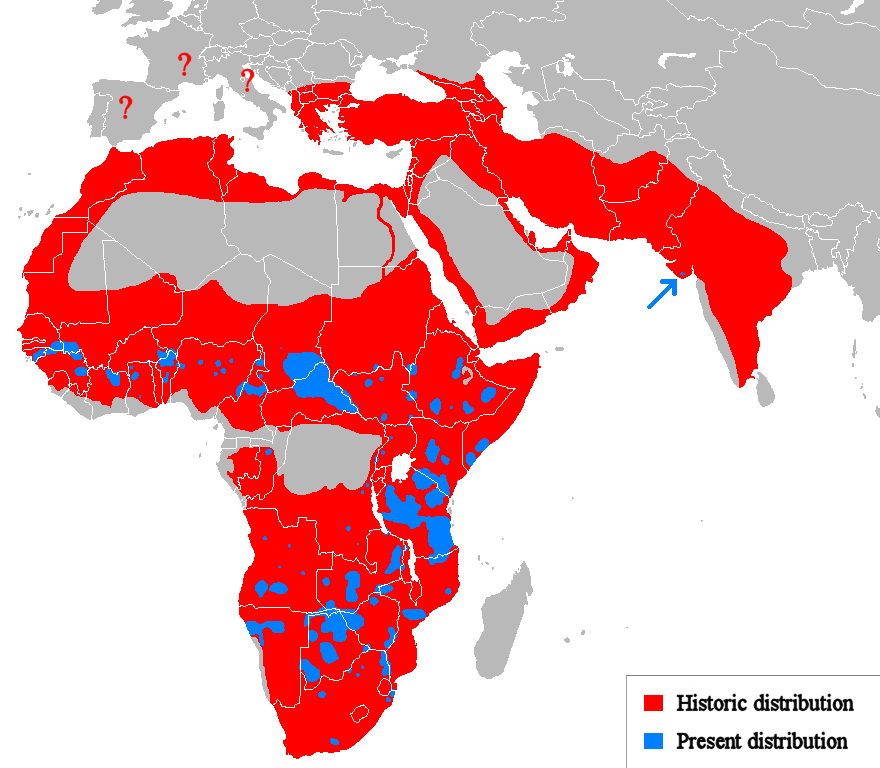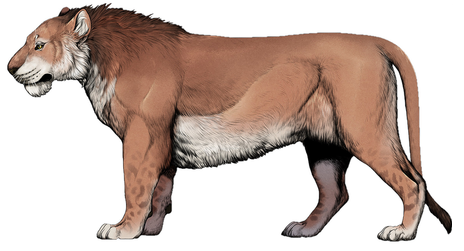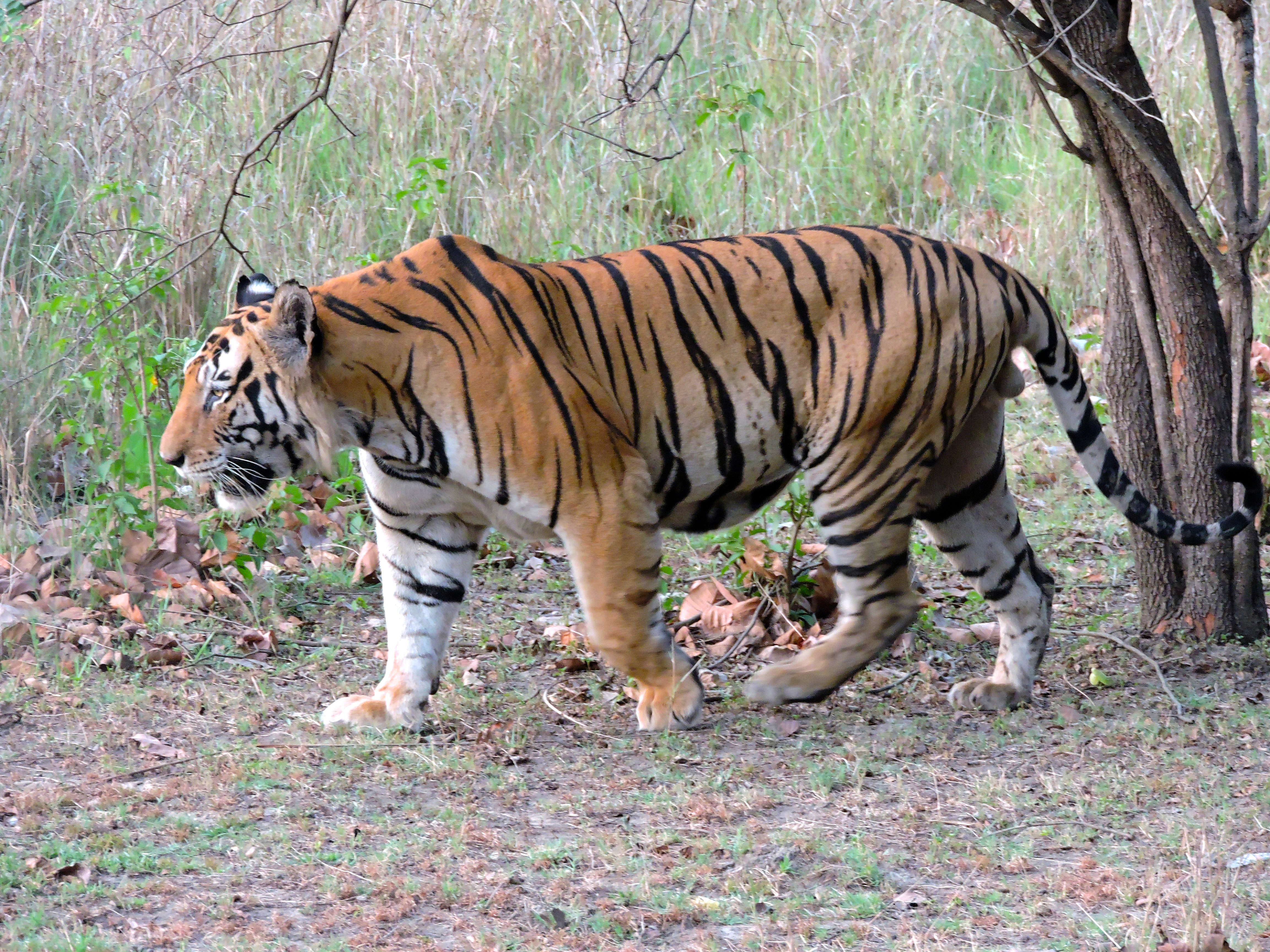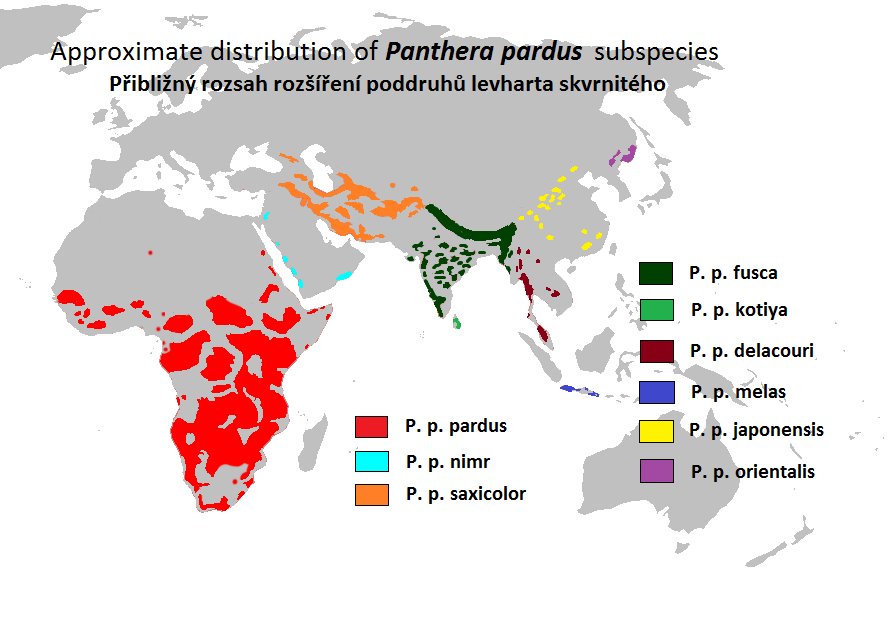|
Panthera
''Panthera'' is a genus within the family (biology), family Felidae, and one of two extant genera in the subfamily Pantherinae. It contains the largest living members of the cat family. There are five living species: the jaguar, leopard, lion, snow leopard and tiger. Numerous extinct species are also named, including the Panthera spelaea, cave lion and American lion. Etymology The word derives from Classical Latin , itself from the Ancient Greek (). Characteristics In ''Panthera'' species, the dorsal profile of the skull is flattish or evenly convex. The frontal interOrbit (anatomy), orbital area is not noticeably elevated, and the area behind the elevation is less steeply sloped. The basic Cranial cavity, cranial axis is nearly horizontal. The inner chamber of the Auditory bulla, bullae is large, the outer small. The partition between them is close to the external auditory meatus. The convexly rounded chin is sloping. All ''Panthera'' species have an incompletely ossified h ... [...More Info...] [...Related Items...] OR: [Wikipedia] [Google] [Baidu] |
Panthera Spelaea
''Panthera spelaea'', commonly known as the cave lion (or less commonly as the steppe lion), is an extinct ''Panthera'' species that was native to Eurasia and northwest North America during the Pleistocene epoch. Genetic analysis of ancient DNA has revealed that while closely related, it was a distinct species genetically isolated from the modern lion (''Panthera leo''), with the genetic divergence between the two species estimated at around 500,000 years ago. The earliest fossils of the ''P. spelaea'' lineage (either regarded as the separate species ''Panthera fossilis'' or the subspecies ''P. spelaea fossilis'') in Eurasia date to around 700,000 years ago (with possible late Early Pleistocene records). It is closely related and probably ancestral to the American lion (''Panthera atrox''). The species ranged from Western Europe to eastern Beringia in North America, and was a prominent member of the mammoth steppe fauna, and an important apex predator across its range along wit ... [...More Info...] [...Related Items...] OR: [Wikipedia] [Google] [Baidu] |
Lion
The lion (''Panthera leo'') is a large Felidae, cat of the genus ''Panthera'', native to Sub-Saharan Africa and India. It has a muscular, broad-chested body (biology), body; a short, rounded head; round ears; and a dark, hairy tuft at the tip of its tail. It is sexually dimorphic; adult male lions are larger than females and have a prominent mane. It is a social species, forming groups called prides. A lion's pride consists of a few adult males, related females, and cubs. Groups of female lions usually hunt together, preying mostly on medium-sized and large ungulates. The lion is an apex predator, apex and keystone predator. The lion inhabits grasslands, savannahs, and shrublands. It is usually more diurnality, diurnal than other wild cats, but when persecuted, it adapts to being active nocturnality, at night and crepuscular, at twilight. During the Neolithic period, the lion ranged throughout Africa and Eurasia, from Southeast Europe to India, but it has been reduced to fr ... [...More Info...] [...Related Items...] OR: [Wikipedia] [Google] [Baidu] |
Tiger
The tiger (''Panthera tigris'') is a large Felidae, cat and a member of the genus ''Panthera'' native to Asia. It has a powerful, muscular body with a large head and paws, a long tail and orange fur with black, mostly vertical stripes. It is traditionally classified into nine Holocene, recent subspecies, though some recognise only two subspecies, mainland Asian tigers and the island tigers of the Sunda Islands. Throughout the tiger's range, it inhabits mainly forests, from coniferous and temperate broadleaf and mixed forests in the Russian Far East and Northeast China to tropical and subtropical moist broadleaf forests on the Indian subcontinent and Southeast Asia. The tiger is an apex predator and preys mainly on ungulates, which it takes by ambush. It lives a mostly solitary life and occupies home ranges, defending these from individuals of the same sex. The range of a male tiger overlaps with that of multiple females with whom he mates. Females give birth to usually two or ... [...More Info...] [...Related Items...] OR: [Wikipedia] [Google] [Baidu] |
Leopard
The leopard (''Panthera pardus'') is one of the five extant cat species in the genus ''Panthera''. It has a pale yellowish to dark golden fur with dark spots grouped in rosettes. Its body is slender and muscular reaching a length of with a long tail and a shoulder height of . Males typically weigh , and females . The leopard was first described in 1758, and several subspecies were proposed in the 19th and 20th centuries. Today, eight subspecies are recognised in its wide range in Africa and Asia. It initially evolved in Africa during the Early Pleistocene, before migrating into Eurasia around the Early–Middle Pleistocene transition. Leopards were formerly present across Europe, but became extinct in the region at around the end of the Late Pleistocene-early Holocene. The leopard is adapted to a variety of habitats ranging from rainforest to steppe, including arid and montane areas. It is an opportunistic predator, hunting mostly ungulates and primates. It relies on it ... [...More Info...] [...Related Items...] OR: [Wikipedia] [Google] [Baidu] |
Jaguar
The jaguar (''Panthera onca'') is a large felidae, cat species and the only extant taxon, living member of the genus ''Panthera'' that is native to the Americas. With a body length of up to and a weight of up to , it is the biggest cat species in the Americas and the List of largest cats, third largest in the world. Its distinctively marked Animal coat, coat features pale yellow to tan colored fur covered by spots that transition to Rosette (zoology), rosettes on the sides, although a melanistic black coat appears in some individuals. The jaguar's powerful bite allows it to pierce the Turtle shell#Carapace, carapaces of turtles and tortoises, and to employ an unusual killing method: it bites directly through the skull of mammalian prey between the ears to deliver a fatal blow to the brain. The modern jaguar's ancestors probably entered the Americas from Eurasia during the Early Pleistocene via the land bridge that once spanned the Bering Strait. Today, the jaguar's range ex ... [...More Info...] [...Related Items...] OR: [Wikipedia] [Google] [Baidu] |
American Lion
The American lion (''Panthera atrox'' (), with the species name meaning "savage" or "cruel", also called the North American lion) is an extinct pantherine cat native to North America during the Late Pleistocene from around 129,000 to 12,800 years ago. Genetic evidence suggests that its closest living relative is the lion (''Panthera leo''), with the American lion representing an offshoot from the lineage of the largely Eurasian cave lion (''Panthera spelaea''), from which it is suggested to have split around 165,000 years ago. Its fossils have been found across North America, from Canada to Mexico. It was about 25% larger than the modern lion, making it one of the largest known felids to ever exist, and a dominant apex predator in North American ecosystems, alongside the sabertooth cats '' Smilodon'' and ''Homotherium''. It has been suggested, like modern lions, they were social animals, although this is not known for sure. The American lion became extinct as part of the end ... [...More Info...] [...Related Items...] OR: [Wikipedia] [Google] [Baidu] |
Pantherinae
The Pantherinae is a subfamily of the Felidae; it was named and first described by Reginald Innes Pocock in 1917 as only including the ''Panthera'' species, but later also came to include the clouded leopards (genus ''Neofelis''). The Pantherinae genetically diverged from a common ancestor between and . Characteristics Pantherinae species are characterised by an imperfectly ossified hyoid bone with elastic tendons that enable their larynx to be mobile. They have a flat rhinarium that only barely reaches the dorsal side of the nose. The area between the nostrils is narrow, and not extended sidewards as in the Felinae. The ''Panthera'' species have a single, rounded, vocal fold with a thick mucosal lining, a large vocalis muscle, and a large cricothyroid muscle with long and narrow membranes. A vocal fold that is longer than enables all but the snow leopard among them to roar, as it has shorter vocal folds of that provide a lower resistance to airflow; this distinction w ... [...More Info...] [...Related Items...] OR: [Wikipedia] [Google] [Baidu] |
Snow Leopard
The snow leopard (''Panthera uncia'') is a species of large cat in the genus ''Panthera'' of the family Felidae. The species is native to the mountain ranges of Central and South Asia. It is listed as Vulnerable on the IUCN Red List because the global population is estimated to number fewer than 10,000 mature individuals and is expected to decline about 10% by 2040. It is mainly threatened by poaching and habitat destruction following infrastructural developments. It inhabits alpine and subalpine zones at elevations of , ranging from eastern Afghanistan, the Himalayas and the Tibetan Plateau to southern Siberia, Mongolia and western China. In the northern part of its range, it also lives at lower elevations. Taxonomically, the snow leopard was long classified in the monotypic genus ''Uncia''. Since phylogenetic studies revealed the relationships among ''Panthera'' species, it has since been considered a member of that genus. Two subspecies were described based on morpho ... [...More Info...] [...Related Items...] OR: [Wikipedia] [Google] [Baidu] |
Felidae
Felidae ( ) is the Family (biology), family of mammals in the Order (biology), order Carnivora colloquially referred to as cats. A member of this family is also called a felid ( ). The 41 extant taxon, extant Felidae species exhibit the greatest diversity in fur patterns of all terrestrial carnivores. Cats have retractile claws, slender muscular bodies and strong flexible forelimbs. Their teeth and facial muscles allow for a powerful bite. They are all obligate carnivores, and most are solitary predators ambushing or stalking their prey. Wild cats occur in Africa, Europe, Asia and the Americas. Some wild cat species are adapted to forest and savanna habitats, some to arid environments, and a few also to wetlands and mountainous terrain. Their activity patterns range from nocturnal and crepuscular to Diurnality, diurnal, depending on their preferred prey species. Reginald Innes Pocock divided the extant Felidae into three subfamilies: the Pantherinae, the Felinae and the Acin ... [...More Info...] [...Related Items...] OR: [Wikipedia] [Google] [Baidu] |
Genus
Genus (; : genera ) is a taxonomic rank above species and below family (taxonomy), family as used in the biological classification of extant taxon, living and fossil organisms as well as Virus classification#ICTV classification, viruses. In binomial nomenclature, the genus name forms the first part of the binomial species name for each species within the genus. :E.g. ''Panthera leo'' (lion) and ''Panthera onca'' (jaguar) are two species within the genus ''Panthera''. ''Panthera'' is a genus within the family Felidae. The composition of a genus is determined by taxonomy (biology), taxonomists. The standards for genus classification are not strictly codified, so different authorities often produce different classifications for genera. There are some general practices used, however, including the idea that a newly defined genus should fulfill these three criteria to be descriptively useful: # monophyly – all descendants of an ancestral taxon are grouped together (i.e. Phylogeneti ... [...More Info...] [...Related Items...] OR: [Wikipedia] [Google] [Baidu] |
Roar
A roar is a type of animal vocalization that is loud, deep and resonating. Many mammals have evolved to produce roars and other roar-like vocals for purposes such as long-distance communication and intimidation. These include various species of big cats, bears, pinnipeds, bovids, deer, elephants and simians. The anatomical basis for the ability to roar often involves modifications to the larynx and hyoid bone and enlarged internal air spaces for low-frequency vocal resonation. While roaring, animals may stretch out their necks and elevate their heads to increase the space for resonance. Definition The definition of "roar" has varied between species. However Weissengruber et al. (2002) has given a more general description of roars as consisting of both a low pitch and low formant. They have used the roars of lions and red deer as quintessential examples of the sound. Other researchers have mentioned similar "roar-like" vocalizations where either the pitch or formant is still ... [...More Info...] [...Related Items...] OR: [Wikipedia] [Google] [Baidu] |







